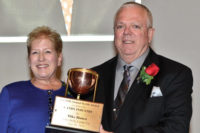Mike Bianco openly professes that he prefers “talking to machines.” Simply put, that’s what he does best. And he’s been doing that at Jelly Belly Candy Co. for 30 years. And yet, this tool-and-die as well as mechanical apprentice — yes, he actually completed both — turned candy maker extraordinaire knows something about talking to people, or shall we say managing them.
As he so succinctly puts it, “So much of managing a factory is about managing people.”
But it took all of Bianco’s self-control to manage his emotions May 20 at the Union League Club in Chicago when he was called out asCandy Industry’s 69th Kettle Recipient.
“I kept telling myself ‘Don’t lose it!’ when I was asked to come to the podium,” he says. But after he thanked his wife, Linda, and his mentors, Herm Rowland Sr. and Russ Albers, Bianco almost, well, lost it.
“Remember, I am Italian, so I do get emotional,” he says.
Bianco isn’t the only one that gets emotional, however. Take long-time friend and nuts-and-bolts comrade-in-arms and chairman of Jelly Belly Candy Co., Herm Rowland, who admits having tears in his eyes when Bianco’s name was called out.
“It was back in 1984 that I hired Mike,” Rowland says. “That’s when Russ Albers [who had just joined the company as vice president and general manager] told me that I had to improve my staff, that I needed someone with advanced mechanical and maintenance experience as well as new equipment knowledge,” says Rowland. Of course, Albers had Bianco in mind as that person, having worked with him at See’s until he came to Jelly Belly Candy Co.
“Well, Russ, Mike and I had dinner one night and both he and I hit it off from the very beginning,” he says.
And it proved to be an auspicious beginning since Bianco was thrust, together with Rowland, into building a brand new facility, the company having outgrown its Oakland site.
“It was a huge undertaking for us,” the company’s chairman says. “We had to find the property, buy it, get the financing and then build the plant.” During that time, Rowland and Bianco would spend many a night in a construction trailer at the plant site. There, on a table sat a layout of the plant, quarter-inch grid paper sitting underneath a plexiglass sheet. On top of the plexiglass, miniaturized moguls, drying rooms, packaging lines, even workers sat.
As Rowland explains, the two, together with the general contractor, would convene in the “war room” each night to review daily progress and plan the next day’s activities and changes.
“I recall one day when they were pouring a 37-ft. tilt-up wall, which included cut-outs for doors upstairs and downstairs and openings for conveyors,” he says. “I looked at it and noticed that the cutouts were two drawings behind. So I start pointing that out when Mike comes to me and says, ‘Let it go, we’ll fix it.’ Mike was good like that.”
Together, Rowland and Bianco managed to get the 100,000-sq.-ft. plant built and producing candy within nine months. It didn’t take long, however, before another 135,000-sq.-ft. addition was necessary. And there too, the nuts-and-bolts team of Rowland and Bianco made it happen.
As Bianco notes, “I know every minute detail of every line.”
Then there was the Thailand project.
“It had become apparent to us that shipping finished goods abroad had become an unsustainable business model because of duties, tariffs and taxes,” explains Robert Simpson, president and coo of Jelly Belly Candy Co.
“If we wanted to continue to be a global markets brand and be competitive, we needed to find a way to manufacture outside of the country,” he says. “Of course, the question was what country would prove to be the ideal location.”
Again, Rowland and Bianco were instrumental in searching out locations, including China. But as Rowland explains, he didn’t want to set up shop in a place where the company only had partial ownership. It was through a friend that Thailand came up in discussion as a possible location. After researching the culture, business climate and operating costs, it became clear that the company could not walk away from this opportunity.
It proved to be, as Bianco says, “A 10,000-mile challenge.”
“It takes all day to get there,” he continues. “And there’s a 14- to 15-hour time difference. On top of that, we were used to U.S. standards and contractors. There’s also a language barrier. Some things just don’t translate on the technical side.”
Despite the process taking three years to complete, Jelly Belly began producing candies in 2009 from Thailand (See Candy Industry Magazine, March 2012 issue).
Indeed, since its construction, the plant has seen two expansions: first, a mezzanine was added in 2011 and then a second building in 2013. And, as Bianco points out, “I’m pleased with it and how it’s run.”
“Mike’s been a warrior throughout the construction in Thailand,” adds Rowland. “I travelled there about three to four times a year, but he was there eight times a year, doing two-week stints. When called upon, he just does it.”
But then that’s part of the company culture, Rowland says. “It’s not about whether we can do it,” he says. “Rather, it’s about how we can do it. And that’s how we approach everything.”
Nonetheless, it helps to have someone of Bianco’s talent and skill to tackle projects, be it building a plant or creating an automated filling line for gift boxes.
“I’m most proud of being able to put together our gift box line,” he says. “It’s a basic concept, but I was able to integrate it into Jelly Belly’s line of products, specifically the 40-flavor gift box. It’s a one-off type machine fundamentally designed for our use. But we’ve been able to expand its capabilities, so in addition to packing multi-flavored gift boxes, we also use it to pack our Tabasco gift box, which has a bottle-shaped insert to hold the candy.”
So what’s been the most challenging project that Bianco has had to face? Well, after some contemplation, he responds.
“Dry rooms,” Bianco says. “We have functional ones now, but there have been a number of attempts to make them work exactly how we want them, controlling air flow, heat, humidity. That, coupled with the number of different products we have, has posed a real challenge for us.”
And speaking of challenges, Bianco’s decision to retire was one that Rowland eventually had to face.
“When he started talking about retirement, I wouldn’t even listen to him,” he says. “I really didn’t want anything to do with it.”
Nonetheless, once Bianco’s wife, Linda, retired, Rowland had to grapple with the inevitable.
“But how do you fill the shoes of a man like Mike?” he asks.
The answer was simple: Let Mikey do it. As Rowland points out, “Mike’s mentored quite a few people to fill his shoes.”
And, as Lisa Brasher, Rowland’s daughter and executive vice-chairman of the company points out, “Mike has done everything, with the exception of sales, marketing and accounting, at the company. With some re-structuring, we’ve spread some of those responsibilities out.”
Moreover, Bianco’s successor, Jeff Brown, has been groomed during the past four years by Bianco himself.
“Fundamentally, we would work really close together when he was vice president of human resources and I headed up operations,” Bianco says. “H.R. and production would work hand-in-hand. Knowing who all the operators were was a big plus for him, and having him in operations during these past four years proved to be a great learning experience. But you have to remember, we have a great engineering department. We have a good plant manufacturing system. Again, it’s all about managing people, everything else comes second.”
And as Jeff Brown, vice president of operations and distribution and a 21-year veteran of Jelly Belly Candy Co., points out, “Mike really led the way for all the improvements in the factories to ensure we make the highest quality products. The operations he put in place during the past three decades have really positioned us well for the future.”
Bianco’s retirement, however, doesn’t mean his departure. He continues to come into the office on select days, working as a consultant for the company.
“I’m somewhat busy doing interpack follow-through right now,” he says. “There are a number of potential projects we’re looking at, such as kitchen modifications and packaging opportunities, and whatever I can do to help Jimmy [Schneider] and Jeff [Brown], I will. Besides, they have enough to do with day-to-day operations, so if I can take some things off their plate, that’s great.”
Moreover, it’s comforting to have Bianco available to share his experiences, his knowledge.
“I’ve made many mistakes in my lifetime,” he says. “I’m happy to share my knowledge and learnings from making those mistakes.”
Of course, that willingness to share also reflects greatly on the kind of person Bianco is.
“He’s the father of the Western Candy Conference,” Rowland says. Noting that the organization has — to this day — remained an all-volunteer group, Rowland cites the comrade and information-sharing that’s characteristic of the group’s annual meetings.
Bianco cites his involvement in the Western Candy Conference as well as the AACT and PMCA as part of the Rowland family’s commitment to those organizations and to the industry.
And although he admits that the industry has changed — consolidation and global competition taking its toll on family-owned confectionery businesses — it still remains the most “human” of industries to work in.
“Having worked in other industries early in my career, I really believe that the confectionery industry is still ahead of everybody when it comes to people being helpful,” Bianco says. “People go out of their way to help.
“Herm and Russ were always very generous with their time, always willing to help people,” he continues. “This is, after all, a community.”
It is not, however, a community immune from changes affecting the industry — be it globalization or technology.
“Everything is more sophisticated today than it was 25 years ago,” Bianco says. “It’s a different world, more laws and regulations, new pieces of equipment that have removed certain elements of the candy making process from the operator.
“And while we’ve progressed to a point where candy making is a combination of art and science, I still maintain that at the end of the day it’s art at work,” he asserts. “There’s a human need to understand the candy you’re making; you just can’t read it off the screen. Because, in the end, candy making is a series of unplanned deviations.”
Does Bianco foresee any unplanned deviations in his life now that he’s retired?
Well, he expects to travel to more dog shows with Linda, who’s both a trainer and a competitor at the shows. And there’s the annual cruise to Alaska in August. Then there’s the wood and machine shops he has that are awaiting his touch.
“And if Herm needs me to check out some equipment somewhere, I’ll be more than happy to go with him,” he adds.
But as Brasher says, “We’re thrilled he’s still with us.” Aren’t we all.




















